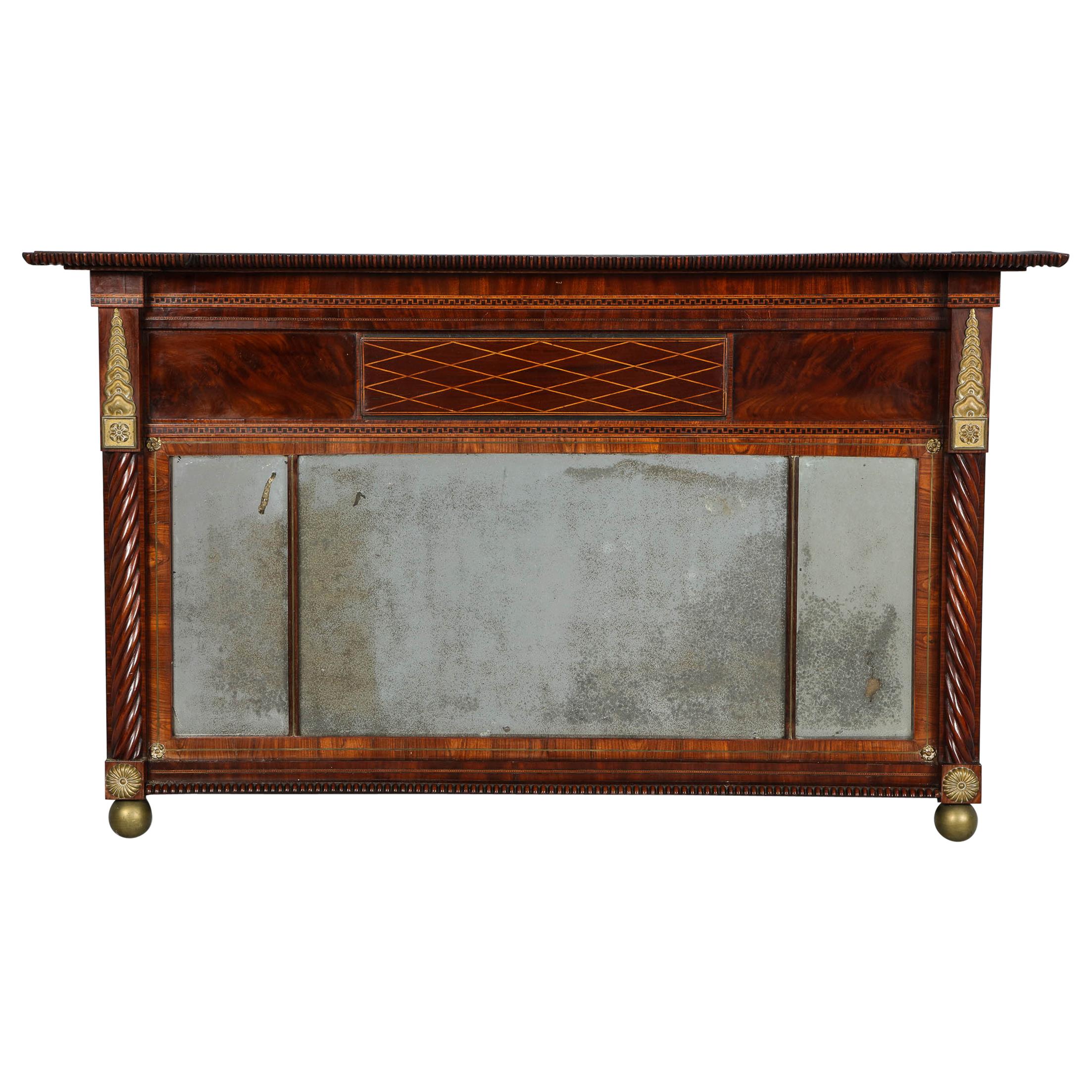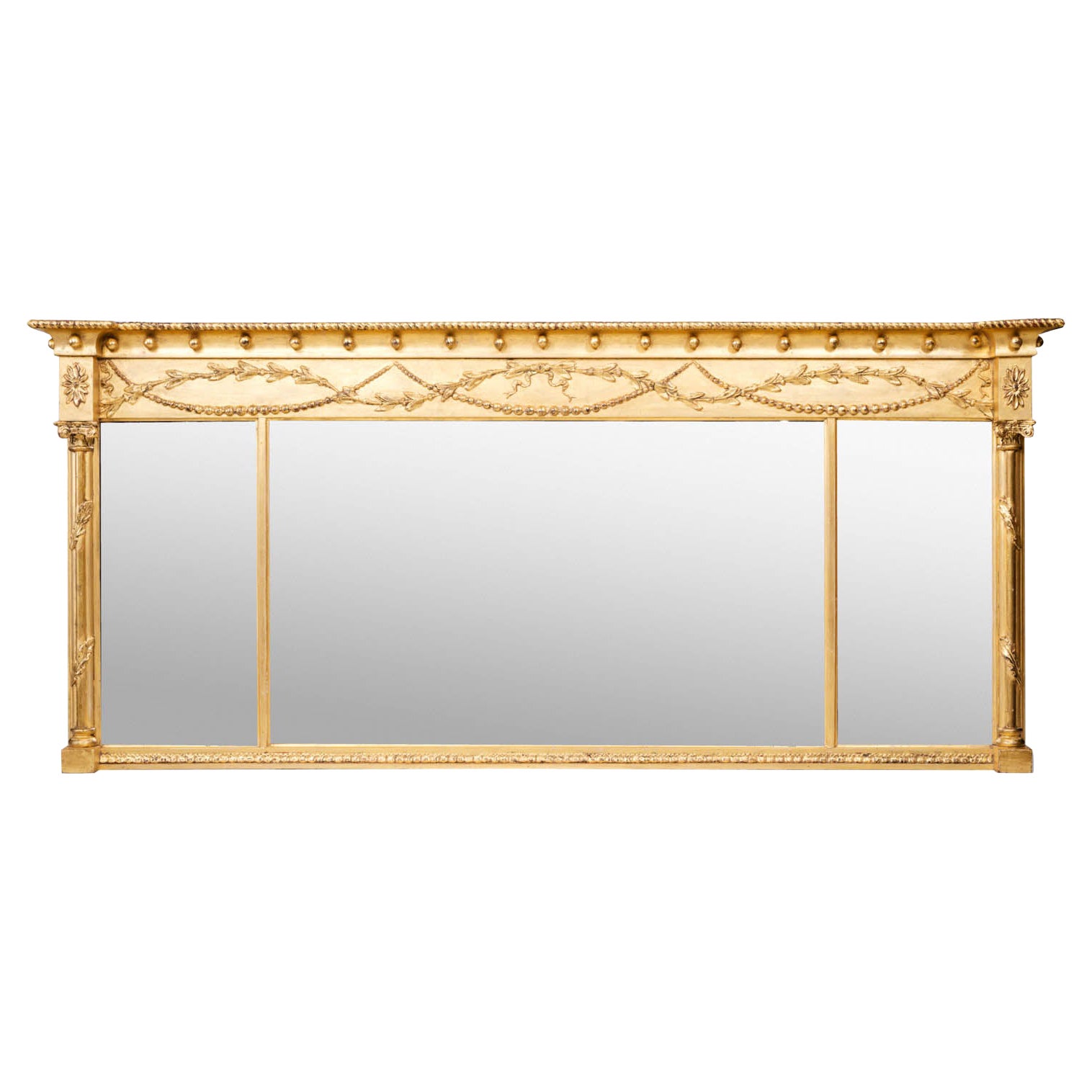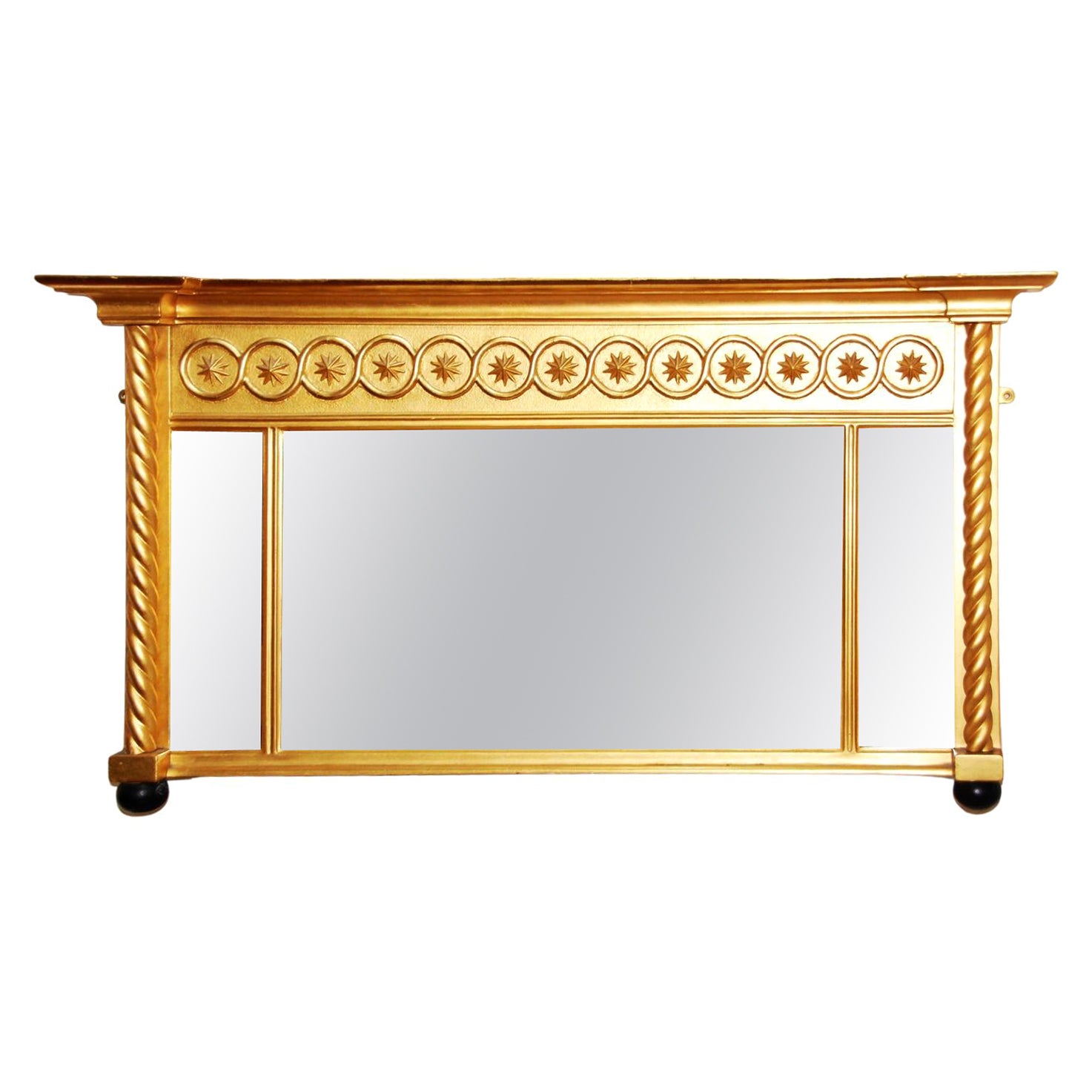Items Similar to Regency Giltwood Overmantel Mirror with Interesting Provenance
Want more images or videos?
Request additional images or videos from the seller
1 of 6
Regency Giltwood Overmantel Mirror with Interesting Provenance
About the Item
This attractive mirror retains all its original plates including the bevelled central plate and the six long and four square mirrors which surround it. The gilt frame has a stepped cornice edged with a bronze egg-and-dart moulding. The sides consist of two reeded pilasters terminating in bronze pharaoh masks and paired feet, English, circa 1810.
Formerly in the possession of Georgie Fame.Georgie Fame (born Clive Powell, 26 June 1943) is an English rhythm and blues and jazz singer, and keyboard player. The musician, who had a string of 1960s hits, is still a popular performer, often working with contemporaries such as Van Morrison and Bill Wyman.[1]
Fame is the only British pop star to have achieved three number one hits with his only Top 10 chart entries: "Yeh, Yeh" in 1964, "Get Away" in 1966 and "The Ballad of Bonnie and Clyde" in 1967.[2]
Georgie Fame (born Clive Powell 26th June, 1943, Leigh, Lancashire) is a British rhythm and blues artist, jazz singer and keyboard player. The one-time rock and roll tour musician, who had a string of 1960's hits, is still a popular performer. His career began at Butlins Holiday Camp, Pwllheli and his first band was called the Dominoes. Later, working in Soho with Cat Stevens and on the Motown review tour with the Supremes, Stevie Wonder and Martha Reeves and the Vandellas, he was heavily influenced by American Jazz and blues music. Ronan O'Rahilly, Fame's manager at the time, claims that he started the offshore pirate radio station, Radio Caroline in 1964, to promote Fame's records which he could not get played on English radio. Fame has collaborated with some of the most successful performers in the world of popular music, most recently Van Morrison, Count Basie, Eric Clapton and as a founding member of Bill Wyman's Rhythm Kings. Last year he performed a benefit concert at the Twickenham Stadium with his two sons on guitar and drums.
- Dimensions:Height: 63.39 in (161 cm)Width: 50.01 in (127 cm)Depth: 0.04 in (1 mm)
- Style:Regency (Of the Period)
- Materials and Techniques:
- Place of Origin:
- Period:
- Date of Manufacture:circa 1815
- Condition:Wear consistent with age and use.
- Seller Location:Lymington, GB
- Reference Number:1stDibs: LU973018887152
About the Seller
5.0
Recognized Seller
These prestigious sellers are industry leaders and represent the highest echelon for item quality and design.
Established in 1982
1stDibs seller since 2013
106 sales on 1stDibs
Typical response time: 4 hours
Associations
LAPADA - The Association of Arts & Antiques Dealers
- ShippingRetrieving quote...Ships From: Lymington, United Kingdom
- Return PolicyA return for this item may be initiated within 14 days of delivery.
More From This SellerView All
- George III Nelson Commemorative Over-Mantle MirrorLocated in Lymington, HampshireA George III Nelson commemorative over-mantle mirror, the giltwood frame with a cornice above a wide frieze flanked by barley twist columns surmounted by sphinx-heads, all enclosing ...Category
Antique 1810s English Mantel Mirrors and Fireplace Mirrors
MaterialsGiltwood
- Attractive Late George I Giltwood MirrorLocated in Lymington, HampshireAn attractive late George I giltwood mirror, the rectangular frame enclosing a bevelled plate and surmounted by a broken S-scroll pediment, ce...Category
Antique 1720s English Wall Mirrors
MaterialsGiltwood
- Pair of Exceptional Giltwood English Chinese Chippendale Period MirrorsLocated in Lymington, HampshireA pair of carved giltwood mirrors, each having connected cartouches, with framed of s-and c-scrolls, waves, and rocaille, surmounted by a carved and gilt phoenix, the top cartouche d...Category
Antique 1840s English Wall Mirrors
MaterialsGiltwood
- Pair of Double Plate Giltwood Pier GlassesLocated in Lymington, HampshireA pair of double plate giltwood pier glasses, one George 1 and the other made to match by George Paton carver and gilder to Queen Victoria, each with the original, probably Queen Anne, shaped and bevelled glasses, the upper plate arched and cut with a central Brunswick star above a border of scrolls along the lower edge, all within a gadrooned frame carved in high and shallow relief with pendant bellflowers and scrolling foliage issuing from flowerheads, the swan-neck pediment centred on a cartouche. One Georgian circa 1730 and the other circa 1840. The older one with a paper label stating ‘Hugh Paton, Printseller and Picture Frame Maker…Her Majesty’s carver and gilder’. English. Footnote: The George I mirror, made c.1730, is an intriguing design that is based on the popular tabernacle shape that was a favourite of the Palladian designers in England such as William Kent and John Vardy. However, the way the slip inside the mirror is shaped indicates the Queen Anne period. This could be particularly significant as both plates in this mirror are original and may well have been re-used Queen Anne period plates. It was very common in even the grandest of homes to update mirrors by changing the style of the frame to suit the latest fashion whilst retaining and re-using the valuable mirror glass itself. This seems all the more likely with the present mirror due to the wonderful engraved Brunswick star and other designs on the top plate-again this form of decoration tends to be associated with mirrors from the William and Mary and Queen Anne periods and is almost always a sign of the highest quality as well. Although it has not been possible to find any provenance for this particular pair of mirrors, we are able to make several educated guesses due to the label on the back of one of them. The label is that of Hugh Paton, a very important and well-known mid-19th century tradesman based in Edinburgh (see below for more details about his business). Paton advertised widely in the Scottish press and from 1842 onwards he began to use the phrase “Carver and gilder to the Queen”, later amended to “Carver and gilder to the Queen and HRH The Duchess of Kent”. Although the Paton business continued under the control of his son, Hugh Paton himself had died by 1867. Therefore, our mirrors must have passed through his hands before that point. It was common practice for restorers to add their label to the back of pieces that they had worked on in some way and it is highly likely that Paton was asked to re-gild the George I mirror and then make a copy to match at the same time. The quality of the copy is quite remarkable and it is virtually impossible to tell the pair apart when viewed on the wall. Given Paton’s reputation and the location of his business, it is likely that the George I mirror belonged to a Scottish family of some prominence who then sought out the very best local gilder to work on their piece and make them a copy. Hugh Paton and his Business Hugh Paton’s business is recorded from 1827-1867, becoming Hugh Paton and Sons after his death in 1868 and flourishing until c.1892. During that time the firm occupied many different premises in Edinburgh including in Princes Street and Adam Square. Unfortunately, the relevant part of the label on our mirrors is damaged so we cannot say with certainty where the firm was based at the time that the mirrors were handled but, as stated above, the presence of the royal crest proves that the date must have been post-1842 and pre-1867 when the name of the firm was changed. As such, the firm would have either been based in Adam Square or at 10 Princes Street. Although it was common for tradesmen and women of this period to have had multi-faceted businesses, Paton operated in a truly astonishing number of markets. A brief biography of the man is maintained on the Science Museum website as he won the contract in 1851 to print the timetables for all of the railway services leaving from Edinburgh and Glasgow. An advert in the Glasgow Sentinel on the 8th of March 1851 mentioned Paton opening new premises in Glasgow specifically to print these timetables and mention was made of the fact that he had received permission to run adverts in the timetable booklets. This is just one example of Paton’s enterprising nature. The same advert described his business as “Printer and publisher, picture frame-maker and print-publisher, carver and gilder to the Queen and her Royal Highness the Duchess of Kent”. Later in the same advert, Paton mentioned that he was taking orders for “window...Category
Antique 19th Century English Wall Mirrors
MaterialsGiltwood
- Napoleon III French oval mirrorsLocated in Lymington, HampshireA large pair of handed Napoleon III French oval mirrors. The cresting carved in wood and representing the arts with sheet music and instruments.Category
Antique 1880s French Napoleon III Wall Mirrors
MaterialsWood
- The Shaving Mirror of Purser WardlawLocated in Lymington, HampshireThis concave, circular shaving mirror is set in a moulded ebonized wood frame. The reverse has a printed trade label stating ‘J Abraham Optician & Mathematical Instrument Maker to hi...Category
Antique Early 1800s English Wall Mirrors
MaterialsEbony
You May Also Like
- Regency Giltwood and Gesso Overmantel MirrorLocated in New York, NYThe reverse breakfront cornice with beaded edge over low-relief diaperwork frieze, above an inset oval mirror plate with beaded slip bordered by fan patera...Category
Antique Early 19th Century English Regency Mantel Mirrors and Fireplace ...
MaterialsGesso, Giltwood
- Scottish Regency Inlaid Overmantel MirrorLocated in Greenwich, CTRare and unusual Scottish Regency period three plate over mantel mirror, having original bronze mounts, highly figured veneer with fine inlay, origina...Category
Antique Early 19th Century Scottish George IV Mantel Mirrors and Firepla...
MaterialsMahogany
- 19th Century Regency Gilt Compartmental Overmantel MirrorLocated in Dublin 8, IE19th century Regency gilt compartmental overmantel mirror. This piece is of the rectangular form and flanked on either side by classical-style columns, with carved scrolling capitals...Category
Antique Early 19th Century English Regency Mantel Mirrors and Fireplace ...
MaterialsMirror, Giltwood
- English Regency Overmantel Tripartite Mirror with Barley Twist Columns and StarsLocated in Wells, MEEnglish Regency giltwood overmantel mirror in tripartite form with barley twist columns. The frieze is a series of repeating stars within circles under a bold cornice. The cornice, f...Category
Antique Early 19th Century English Regency Mantel Mirrors and Fireplace ...
MaterialsMirror, Wood, Giltwood
- Pair of Regency Giltwood MirrorsLocated in Kittery Point, MEEach oval beveled mirror plate within a rope-twist frame, with an apron ending in a bracket, decorated overall with rosettes, foliage, leaf tips and fluting.Category
Antique 19th Century British Regency Mantel Mirrors and Fireplace Mirrors
MaterialsWood, Glass
- Carved Giltwood Regency Eagle Serpent MirrorLocated in Lymington, GBA carved giltwood mirror of classic Regency design. Surmounted by a displaying eagle set upon rock work. Circa 1820. The frame surrounded with a geometric-design border with intertwining serpents and oak leaves to the base. Nb. giltwood mirrors with carved serpents...Category
Antique Early 19th Century Regency Wall Mirrors
MaterialsGiltwood
Recently Viewed
View AllMore Ways To Browse
Interesting Antique
Interesting Mirror
Regency Giltwood
Regency Giltwood Mirror
Mantel Giltwood Mirror
Bronze Mirror Pair
Star Mirror
Mirrored Star
Bronze Pair Of Mirrors
Antique Long Mirror
Antique Mirror Long
Antique Long Mirror Mirrors
Long Antique Mirror
Long Antique Mirrors
Long Mirror Antique
Pair Of Mirrors 1960s
Pair Regency Mirror
Pair Of Regency Mirrors





